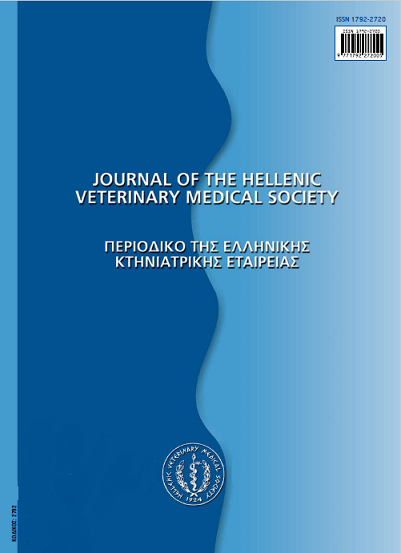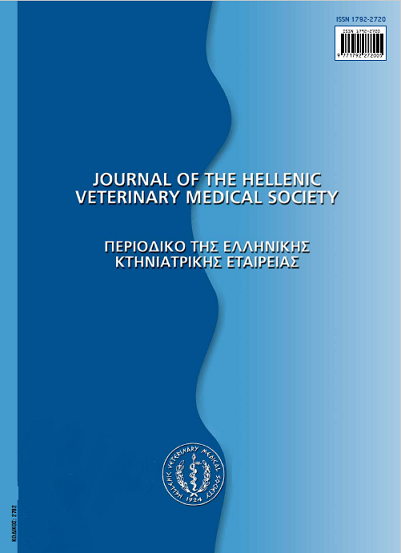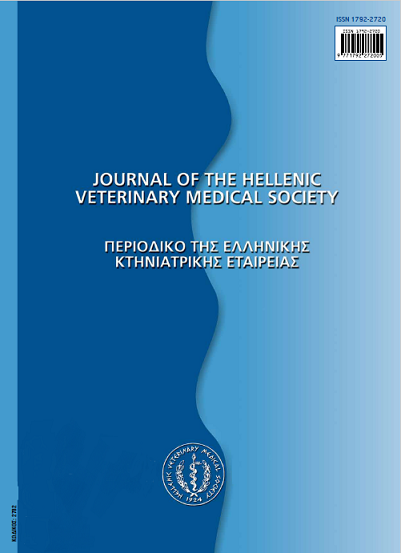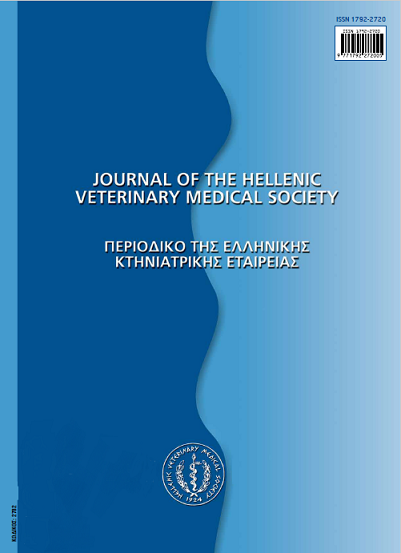Εντοπισμός και μορφολογική ταυτοποίηση των μυξοσποριδίων και εκτίμηση της επίδρασης της κατάψυξης και της χρώσης Giemsa στο μέγεθος των σπόρων των μυξοσποριδίων

Περίληψη
Τα μυξοσπορία Enteromyxum leei, Ceratomyxa spp., Polysporoplasma sparis είναι από τα σημαντικότερα και πιο συχνά παρατηρούμενα μυξοσπορίδια στα εκτρεφόμενα μεσογειακά ευρΰαλα ψάρια. Στη συγκεκριμένη έρευνα, αρχικά, έγινε μια εκτίμηση της εποχικότητας και του ποσοστού προσβολής των μυξοσποριδίων που παρασιτούν σε εκτρεφόμενα ψάρια στην Ελλάδα. Το κύριο όργανο στόχος σε όλα τα προσβεβλημένα ψάρια ήταν το έντερο, ενώ ανιχνεύτηκαν, επίσης, σε χοληδόχο κύστη και νεφρό. Το καλοκαίρι, το στατιστικά μεγαλύτερο ποσοστό προσβολής παρατηρείται στη χιόνα. To P. sparis παρατηρήθηκε σε τσίπουρα που αποτελεί τον κΰριο ξενιστή του παράσιτου, ενώ παρατηρήθηκε σε μικρότερα ποσοστά προσβολής και σε εκτρεφόμενη χιόνα. Το κΰριο όργανο στόχος σε όλα τα προσβεβλημένα ψάρια ήταν ο νεφρός. Το καλοκαίρι παρατηρείται το στατιστικά μεγαλύτερο ποσοστό προσβολής στην τσιπούρα. Ώριμοι σπόροι του παράσιτου Ceratomyxa diplodae παρατηρήθηκαν σε χιόνα. Το κύριο όργανο στόχος του παράσιτου, που προσβλήθηκε στα εκτρεφόμενα ψάρια στην παρούσα έρευνα, ήταν η χοληδόχος κύστη. Επίσης, έγινε παρατήρηση της μορφολογίας και μέτρηση των σπόρων των παραπάνω μυξοσποριδίων. Στη συγκεκριμένη έρευνα,μελετήθηκε επίσης η επίδραση της κατάψυξης στους -20° C (για 1 και 6 μήνες) και της χρώσης Giemsa στο μέγεθος των σπόρων των μυξοσποριδίων που ανιχνεύτηκαν. Σύμφωνα με τα αποτελέσματα, η κατάψυξη για 6 μήνες και η χρώση Giemsa μείωσαν σημαντικά το μέγεθος των ώριμων σπόρων. Τέλος, έγινε τυποποίηση των τριών διαφορετικών ειδών μυξοσποριδίων που παρατηρήθηκαν με χρώση Giemsa. Τα επιχρίσματα της παρασιτολογικής εξέτασης βάφτηκαν με Giemsa σύμφωνα με δεδομένο πρωτόκολλο. Σύμφωνα με τα αποτελέσματα, για το Ε. leei, ο ιδανικός χρόνος παραμονής του επιχρίσματος στο διάλυμα Giemsaγια ικανοποιητική χρώση των σπόρων ήταν 20 min, για το C. diplodae ήταν 30 min και για το P. spans ήταν 24 min.
Λεπτομέρειες άρθρου
- Πώς να δημιουργήσετε Αναφορές
-
GATZIA (Κ. ΓΚΑΤΖΙΑ) K., TZIRONI (Ε. ΤΖΙΡΩΝΗ) E., BITCHAVA (Κ. ΜΠΙΤΧΑΒΑ) K., & ATHANASSOPOULOU (Φ. ΑΘΑΝΑΣΟΠΟΥΛΟΥ) F. (2017). Εντοπισμός και μορφολογική ταυτοποίηση των μυξοσποριδίων και εκτίμηση της επίδρασης της κατάψυξης και της χρώσης Giemsa στο μέγεθος των σπόρων των μυξοσποριδίων. Περιοδικό της Ελληνικής Κτηνιατρικής Εταιρείας, 60(1), 39–50. https://doi.org/10.12681/jhvms.14913
- Τεύχος
- Τόμ. 60 Αρ. 1 (2009)
- Ενότητα
- Research Articles
Οι συγγραφείς των άρθρων που δημοσιεύονται στο περιοδικό διατηρούν τα δικαιώματα πνευματικής ιδιοκτησίας επί των άρθρων τους, δίνοντας στο περιοδικό το δικαίωμα της πρώτης δημοσίευσης.
Άρθρα που δημοσιεύονται στο περιοδικό διατίθενται με άδεια Creative Commons 4.0 Non Commercial και σύμφωνα με την άδεια μπορούν να χρησιμοποιούνται ελεύθερα, με αναφορά στο/στη συγγραφέα και στην πρώτη δημοσίευση για μη κερδοσκοπικούς σκοπούς.
Οι συγγραφείς μπορούν να καταθέσουν το άρθρο σε ιδρυματικό ή άλλο αποθετήριο ή/και να το δημοσιεύσουν σε άλλη έκδοση, με υποχρεωτική την αναφορά πρώτης δημοσίευσης στο J Hellenic Vet Med Soc
Οι συγγραφείς ενθαρρύνονται να καταθέσουν σε αποθετήριο ή να δημοσιεύσουν την εργασία τους στο διαδίκτυο πριν ή κατά τη διαδικασία υποβολής και αξιολόγησής της.









